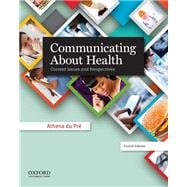An ideal combination of communication theory and practical advice, Communicating About Health: Current Issues and Perspectives, Fourth Edition, is an indispensable resource for readers looking to improve their communication abilities in the health care field. Written by Athena du Pré--an experienced researcher and noted scholar--the text offers an excellent balance of theory and practice; research and pedagogy; coverage of patient/caregiver issues; and material on the current, historical, and philosophical backgrounds of communication in health care. In addition to enhancing features found in the previous edition, this new edition includes a greater emphasis on theory, narrative, and technology in order to reflect changes in the health industry.
What's New to the Fourth Edition?
* A new chapter--eHealth, mHealth, and Telemedicine--describes the global impact of smartphone and tablet technology, tailored health messages, and the Internet on the health industry
* A new chapter, Health Care Administration, Human Resources, Marketing, and PR, provides in-depth coverage of the contributions and communication strategies involved in leadership, morale, service excellence, community engagement, and more
* An expanded discussion of communication not only involves physicians and nurses but also pharmacists, allied health personnel, dentists, therapists, and others
* New features--"Can You Guess?," "What Do You Think?," "Check It Out!," and "In Your Experience"--offer a higher level of engagement with students and stimulate critical thinking and discussion
Support Package (contact your Oxford sales representative or call 800-280-0280 to request these resources)
* An interactive website, known as a Prezi, is available for each chapter at www.oup.com/us/dupre and includes videos, activities, discussion questions, key points, and more. Suitable for use in class or online.
* An Instructor's Manual and Test Bank, available both in print and online at www.oup.com/us/dupre, features sample syllabi, test questions, self-assessment activities, background reading, and more.








